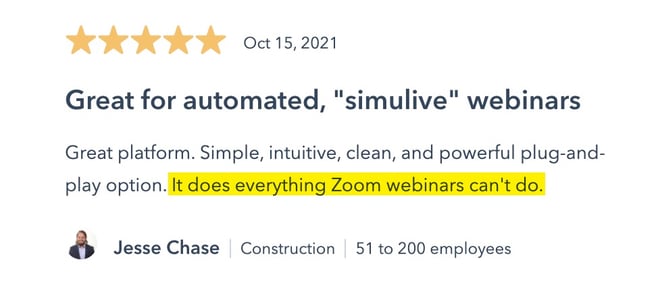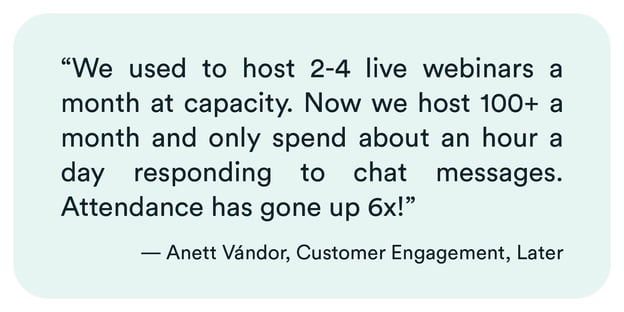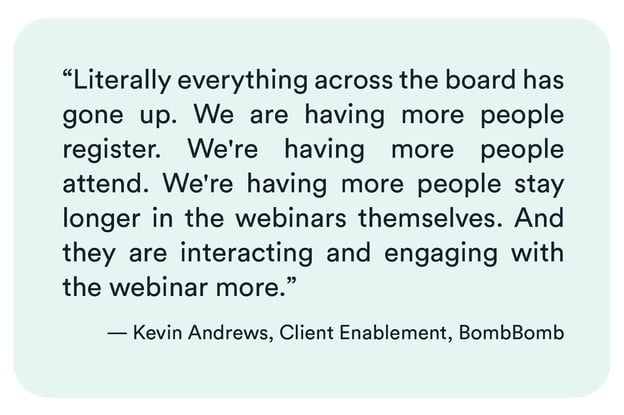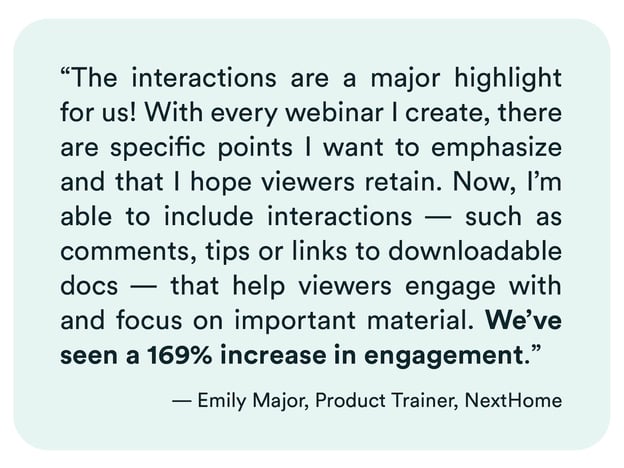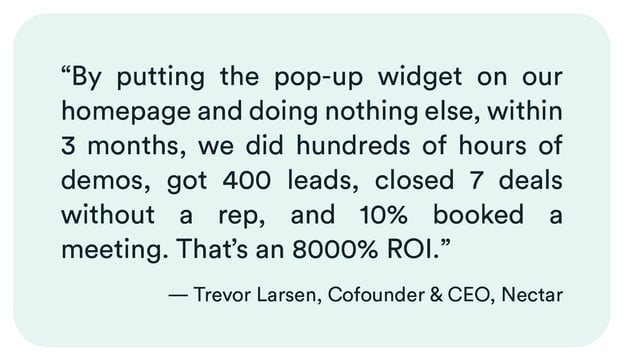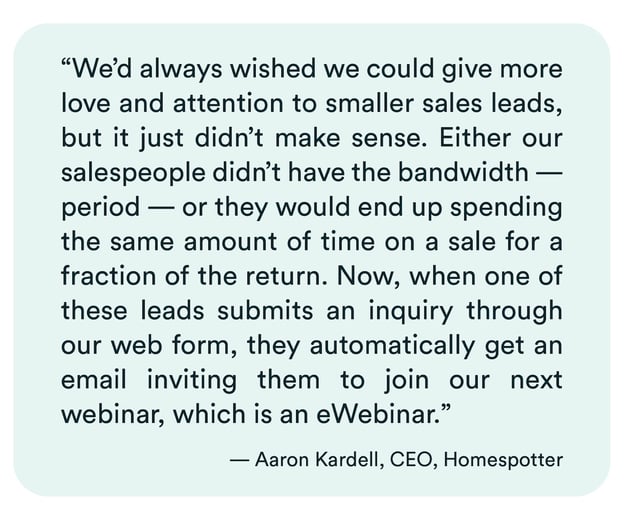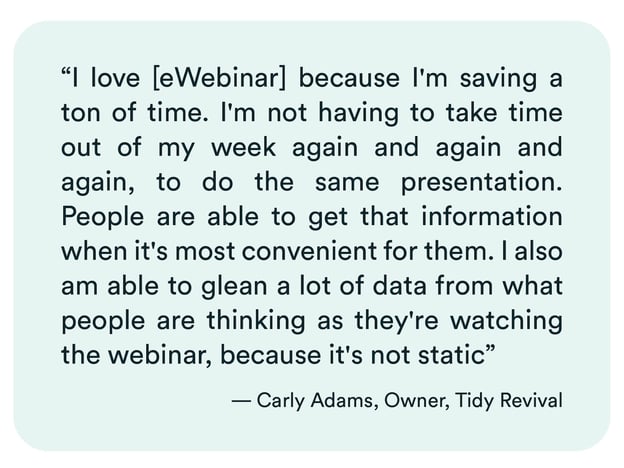Zoom Webinar vs Meeting: How They Compare + Their Limitations
Zoom Webinars and Zoom Meetings are similar in functionality, but have fundamental differences and serve different purposes. This article describes those key differences, compares the features and limitations of Zoom Webinars vs Zoom Meetings, and explains what each should be used for.
Later on, we also introduce eWebinar, an on-demand webinar platform that can be used in place of either Zoom webinars or meetings to automate and scale the kinds of repeat presentations you must give over and over again.
Here is what we will cover in this post:
- What is the difference between a Zoom Webinar vs Meeting?
- What is a Zoom Webinar and what should it be used for?
- What is a Zoom Meeting and what should it be used for?
- How are Zoom Webinars and Meetings the same?
- What are the limitations of Zoom Webinars and Meetings?
- How do you overcome the limitations of Zoom Webinars and Meetings?
- What benefits come from automating your Zoom Webinars and Meetings?
- How do you automate your Zoom Webinars and Meetings?
If you are simply looking for a bulleted, side-by-side feature comparison of Zoom Meetings vs Webinars, check out this article from Zoom’s knowledge base.
What is the difference between a Zoom Webinar vs Meeting?
The easiest way to understand the difference between a Zoom Webinar vs Meeting is to look at their non-digital counterparts in the real world. A webinar is the virtual equivalent of a seminar or lecture. And a virtual meeting is the same as, well, a meeting, like the kind you would hold in a conference room at your office or in your living room with friends and family.
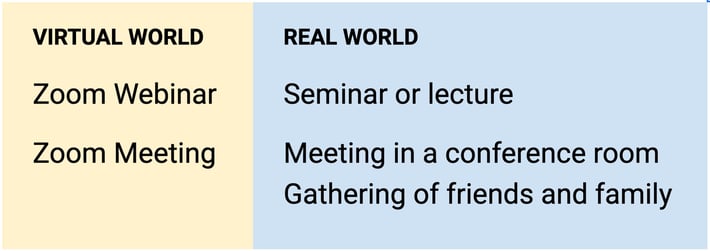 Zoom built the functionality of its webinars and meetings to mimic these real-life scenarios, so let’s look at the differences between the two through that lens.
Zoom built the functionality of its webinars and meetings to mimic these real-life scenarios, so let’s look at the differences between the two through that lens.
What is a Zoom Webinar and what should it be used for?

If a Zoom Webinar is just a virtual seminar, think of how a seminar works in real life.
A seminar is held in an auditorium or lecture hall. There is usually one speaker (or sometimes a panel of speakers) presenting to a large group. There may be some interaction between the speaker and large audience in the form of an informal poll (i.e. “By show of hands, how many of you…?”) or Q&A at the end, but the experience for the audience is more or less passive. They sit and listen to the speaker and don’t interact with each other.
This is exactly the kind of event Zoom Webinars are good for. They just happen in a virtual lecture hall.
In practical terms, this includes things like:
- Educational seminars and lectures
- Town halls and all-hands meetings
- Quarterly/annual company updates
Here is how this translates to the basic features and experience of a Zoom Webinar:
|
Audio |
The audience is only able to listen in. They can’t be heard by others unless they are unmuted by the host to ask a question. |
|
Video |
The audience can’t be seen or see each other. Only hosts, co-hosts, and panelists can turn on their video and be seen. |
|
Visibility |
Only hosts, co-hosts, and panelists can see the list of audience members in attendance. For the audience, it’s anonymous. |
|
Size |
Large audiences can range in size from 500 - 50,000 attendees. |
Notable features Zoom Webinars have that Zoom Meetings do not are a PayPal integration (in case you want to charge for your live webinars) and the ability to hold practice sessions.
What is a Zoom Meeting and what should it be used for?

If Zoom Meetings are the virtual equivalent of the meetings you have in conference rooms at work or gatherings in your home, think about what these kinds of meetings are like in real life.
A meeting like this is usually with a pretty small group. You are able to talk with each other and collaborate easily. If you need to, you can split up into smaller groups for smaller conversations.
This is exactly the kind of event Zoom Meetings are good for.
In practical terms, this includes things like:
- Face-to-face video conferencing with customers
- Virtual catch-ups between friends and family
- Collaborative meetings between employees
- White-glove training and onboarding sessions
Here is how this translates to the basic features and experience of a Zoom Meeting:
|
Audio |
Both meeting hosts and participants can speak and be heard, though ultimate control over who is muted/unmuted belongs to the host. |
|
Video |
Hosts and participants alike can be seen by others, as long as they turn on their video. |
|
Visibility |
Everyone can see the participant list of who’s attending. |
|
Size |
Meetings are smaller, limited to 100 participants (though an add-on will increase that to 1000 for large meeting audiences). |
Notable features Zoom Meetings have that Zoom Webinars do not are breakout rooms and waiting rooms.
How are Zoom Webinars and Meetings the same?
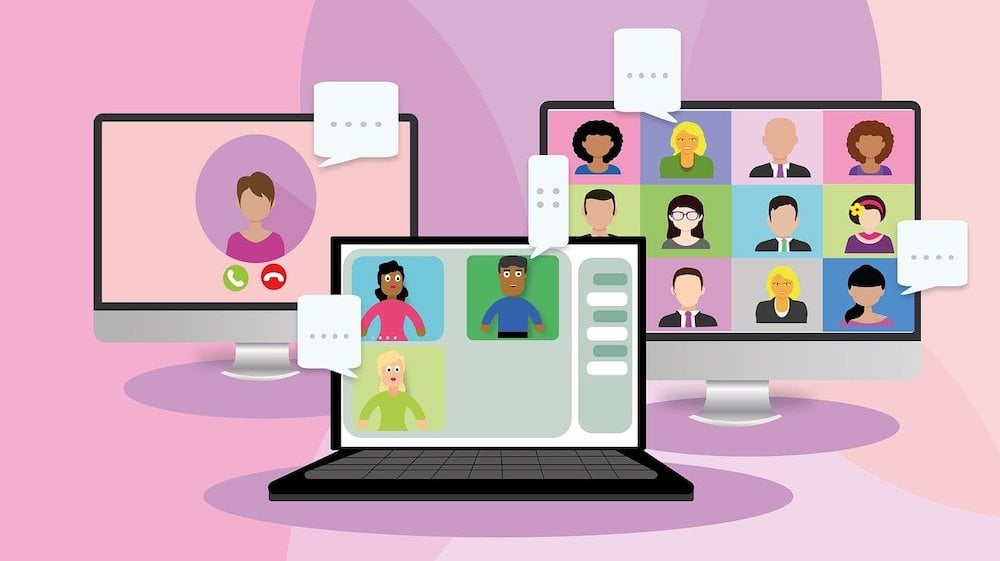
Zoom Webinars and Meetings, as virtual events, are more similar than they are different. The features they share include:
- Meeting Chat
- Whiteboard
- Screen Sharing
- Virtual backgrounds
- Closed Captioning
- Annotations
- Meeting Reactions (i.e. raise hand)
- Polling Questions
- Surveys
- Registration
However, it is important to note there are nuances between how these features work in Zoom Meetings and Webinars. In the context of video webinars, they are generally intended to be used by the host only, while in meetings they are more collaborative and can be made available to anyone.
If you want to see a side-by-side comparison of the features of Zoom Webinars and Zoom Meetings, so you can better understand their similarities and differences (and their pricing), read this article from Zoom’s knowledge base.
What are the limitations of Zoom Webinars and Meetings?
The limitations of Zoom Meetings and Zoom Webinars are not unique to Zoom. Rather, they are inherent to the nature of certain kinds — though not all kinds — of live webinars and livestream meetings. We’re specifically talking about the presentations you give repeatedly, the ones where you must deliver the same exact content every time, like demos and pitches by sales teams, onboarding and training sessions by customer success teams, and any other kind of presentation a company must do over and over again in the regular course of business.
The problem these types of events pose when done as a Zoom Webinar or Meeting (or using any other live webinar or virtual meeting platform) is they are unscalable since they must always be presented live. This one limitation leads to many more:
- Presentations become a huge time suck, preventing you from focusing on other things that are also important.
- You can only schedule so many sessions without having to hire more people.
- Teams get burnt out and demoralized from repeatedly having to give the same presentation, whether it’s to 2 or 200.
- Attendance rates are lackluster because people can’t join a session when they want, especially at a peak moment of interest. (What consumers expect to be able to do nowadays.)
- It is impossible to accommodate the schedules of all potential attendees, especially those in different time zones, which means people always fall through the cracks.
Companies often try to overcome these limitations by recording their presentations and making them available as simple videos, but that means giving up the things that made their live webinars and virtual meetings so valuable, like lead capture, interactive sessions for attendees, customer engagement and feedback, and — most importantly — the ability to chat and answer questions in real time. It's a terrible catch-22.
If you are interested in learning more about the limitations of Zoom Meetings, check out this entire post we wrote on the topic:
Zoom Meetings Limitations: What They Are + How to Work Around Them
How do you overcome the limitations of Zoom Webinars and Meetings?
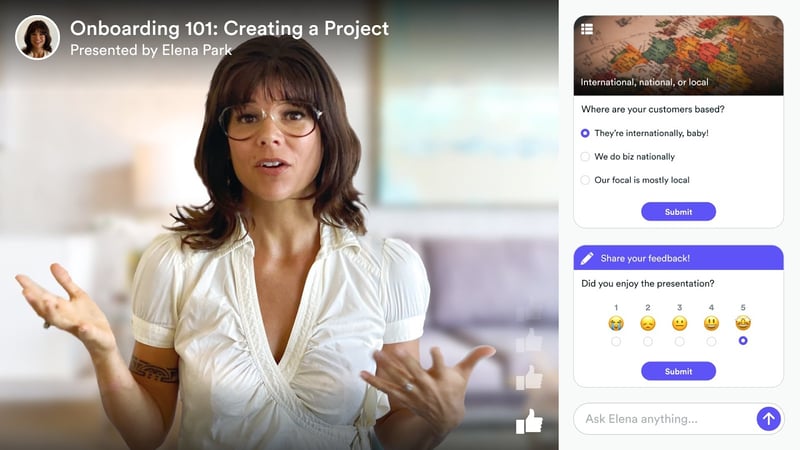
eWebinar is an automated webinar software platform that combines pre-recorded video with live (or asynchronous) chat and preset interactions to consistently deliver an engaging experience for attendees.
eWebinar lets you turn any video into an interactive, automated webinar you can set on a recurring schedule and make available around the clock — at any time in any time zone — or on demand.
With eWebinar, you can put your webinars and virtual meetings on autopilot without sacrificing the engagement, communication, lots of audience participation, and direct feedback you get from live events. If anything, you’ll see these things increase.
Does this sound too good to be true? It isn’t.
Read what our customers are saying about eWebinar or check out our reviews on Capterra. (At the time of writing, we have an average 5-star rating.)
To learn more about eWebinar and its features, join this 20-minute on-demand webinar — which uses eWebinar to demo eWebinar so you can see it in action and experience it for yourself — or sign up for a free trial today.
What benefits come from automating your Zoom Webinars and Meetings?
eWebinar has applications in every industry, since every company has presentations they must do repeatedly: product demos, sales pitches, trainings, onboarding, ongoing education, product updates, content marketing, and lead generation.
Three popular use cases and customer types for eWebinar are:
- Customer Success teams at SaaS Companies
- Sales teams at SaaS companies
- Solo entrepreneurs, course creators, and coaches
Customer Success teams at SaaS Companies
Sales teams at SaaS companies
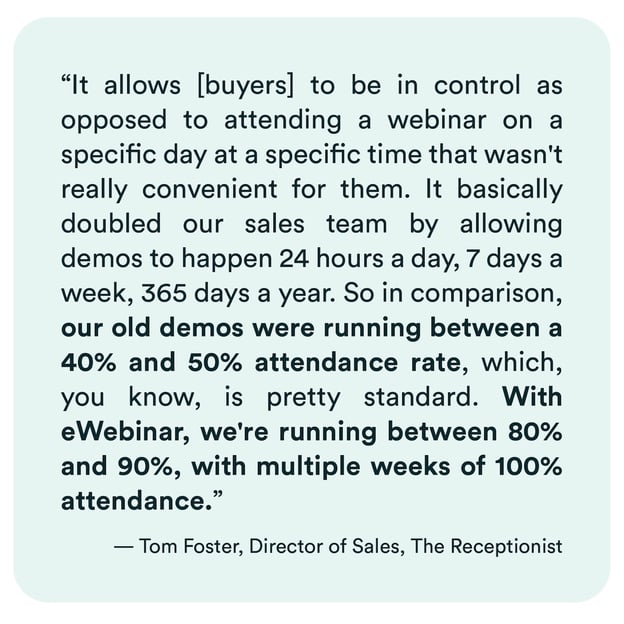 Read more from The Receptionist →
Read more from The Receptionist →
Solo entrepreneurs, course creators, and coaches
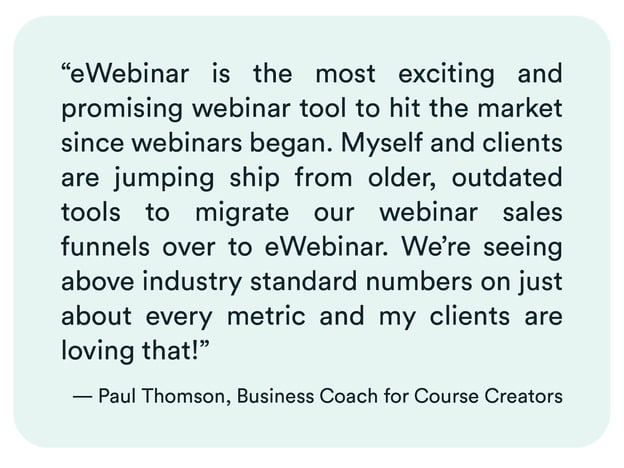
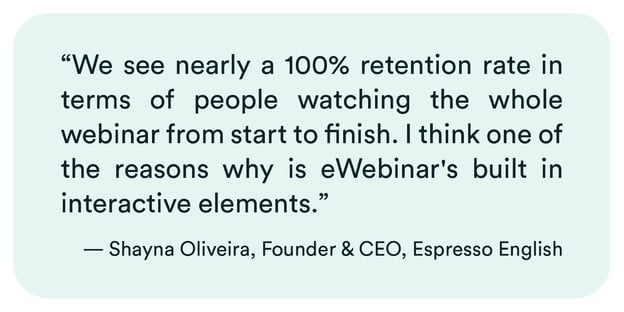 Read more from Espresso English →
Read more from Espresso English →
How do you automate your Zoom Webinars and Meetings?
Though live webinars and virtual meetings, like those made possible by Zoom Webinars and Zoom Meetings, will always be important and valuable, that does not mean some of them can’t be automated and made available around the clock with eWebinar.
We make this seamless and easy via our direct integration with Zoom. All you have to do is connect your Zoom Account to your eWebinar account and you can import your cloud recordings from Zoom with a click!
If you are interested in experiencing the benefits of webinar automation or you simply want to learn more about eWebinar, join our 20-minute product demo or sign up for a free trial today!




